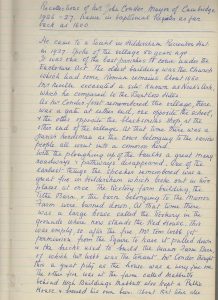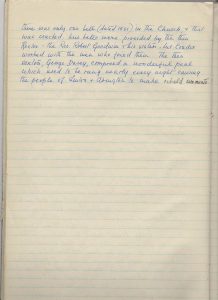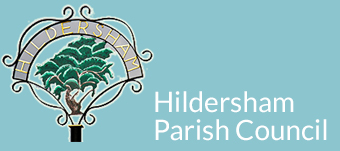
Hildersham: History
Hildersham – whose name was noted in 1086 in the Domesday Book as Hildricesham, “the hām of Hildrīc” – is a small and narrow parish of 616 hectares, straddling the valley of the Granta between the chalk uplands, with boundaries formed by the Cambridge-Colchester Roman Road to the north, and the Essex border to the south. These parish boundaries lie more than 80m and 100m above sea level respectively, although the village itself is situated on lower-lying gravel and alluvial soils some 30m deep, on either side of the small winding river. There are also a few high points, such as Furze Hill, where the chalk is capped with clay and gravel. Close to the river are meadows that were used as common land. From the time of the Domesday Book until the end of the whole mediaeval period, the parish was noted as containing extensive areas of woodland; one example was Hildersham Wood on the Essex border, which still exists today.
Hildersham was the last parish in Cambridgeshire to have its common land enclosed, following the Enclosure Act of April 1889.
Parish Council
In 1894, the Local Government Act introduced Parish Councils to rural areas. But, at that time, with a population of just over 200, Hildersham was not considered large enough to merit a Parish Council. A Parish Meeting was therefore set up instead, as seen from this extract from the Minutes at the time:
The “Local Government act of 1894” instituted the beginning of the annual Parish Meeting to administer the affairs of the parish & section 19 (7) officially transferred the responsibility of the Trustees of the Allotments & Recreation Ground from the Churchwardens & Overseers of the Poor to the Chairman & Overseers of the annual Parish Meeting.
The first Parish Meeting was held on 4th December 1894 at the Schoolroom. The first Chairman was the Revd. Robert Goodwin, and Mr. George Henry Potter of Manor Farm was elected as the District Councillor.
On 25th March 1909, the powers were extended to make Hildersham a full Parish Council.
Local Records
Cambridgeshire has two principal depositories of local records:
- the Cambridgeshire Collection, currently located at the Cambridge Central Library; and:
- Cambridgeshire Archives at The Dock, Ely.
Cambridgeshire Archives records can be found on their online catalogue, CALM. (For records relating particularly to Hildersham, see here).
As of 2021, it is hoped that Cambridgeshire Archives (Ely) records will be augmented by material from the holdings of Hildersham local historian, Andrew Westwood-Bate, listed here:
Hildersham Archives – September 2020
Some examples of documents from this archive (concerning John Conden, Mayor of Cambridge in the 1920s) are illustrated below. (The second document ends with a reference to certain “ribald comments” made by the villagers of Linton and Abington):

John Conden – 1

John Conden – 2
Other helpful links:
Cambridgeshire Memories And Reflections By Mike Petty
A Cambridgeshire Scrapbook 1897-1990 – Mike Petty (1920)
Archaeology of the Cambridge Region (C. Fox, 1923)
Hildersham War Memorial (Roll of Honour)
National Archives: Cambridgeshire

